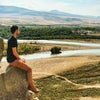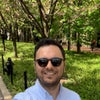The United States Holocaust Memorial Museum (USHMM) is the United States' living memorial to the Holocaust. Located among monuments and memorial on the National Mall in Washington, D.C., the USHMM is dedicated to help leaders and citizens of the world to confront hatred, prevent genocide, promote human dignity, and strengthen democracy.
In 1980, the U.S. Congress authorized the creation of the Museum based on the 1979 report of the President's Commission of the Holocaust established by Jimmy Carter. With the support of Miles Lerman the Museum raised approximately $190 million dollars for the construction of the Museum and acquisition of artifacts. The Museum building was designed by James Ingo Freed (a Jewish survivor of Nazi Germany), of Pei Cobb Freed and Partners. Additionally, Maurice N. Finegold of Finegold Alexander + Associates Inc, was a consulting architect on the project. Though the outside of the building is monumental with clean lines, in keeping with the large governmental buildings in the immediate context, the interior was meant to provoke more intimate and visceral responses.
Since its dedication in 1993, the Museum has welcomed nearly 30 million visitors, including more than 8 million school children and 85 heads of state. Today 90 percent of the Museum’s visitors are not Jewish, and their Web site, the world’s leading online authority on the Holocaust, had 15 million visits in 2006 from an average of 100 different countries daily.
The Permanent Exhibition of the USHMM occupies the majority of the floor space of the Museum, beginning on the fourth floor and ending on the second floor. It is the chronological history of the Holocaust through more than 900 artifacts, 70 video monitors, and four theaters that include historic film footage and eyewitness testimonies. The fourth floor covers the years 1933 to 1940, focusing on the exclusion of Jews from European society to the buildup to the Second World War with the invasion of Poland by Germany. The third floor covers the years 1940 to 1945 focusing on the Final Solution - particularly the Concentration Camps, killing centers, and ghettos. The second floor focuses on resistance, rescue, and liberation, and the post-war years. At the end of the exhibition there is a testimony film of Holocaust survivors that runs continuously. Most first-time visitors spend an average of two to three hours in this self-guided exhibition and it is recommended for visitors 11 years of age and older.
The Tower of Faces is part of the Permanent Exhibition of the Museum. It forms a three-story tower within the building, and is lined with about a thousand photographs of everyday life before the Holocaust in the small Lithuania shtetl (village) of Eišiškės. There are photographs of family groups, weddings, picnics, swimming parties, sporting events, holiday celebrations, gardening, bicycling and other aspects of daily life. Before the war, the shtetl population was about 3,500, almost all Jewish. In September 1941, German SS, assisted by Lithuanian auxiliaries, rounded up the people of the shtetl, along with about a thousand Jews from the surrounding area, and systematically killed them all.
The photographs were taken by Yitzhak Uri Katz and his associates. They are part of the Yaffa Eliach Shtetl Collection. Dr. Eliach lived in Eišiškės as a young child, and is the granddaughter of Yitzhak Uri Katz.
Before entering the Permanent Exhibition, a visitor receives an Identification Card that explains the story of a Holocaust victim or survivor of the event. The Museum considers a Holocaust victim or survivor as whatever person, Jewish or non-Jewish, that was displaced, persecuted, or discriminated against for political, social, racial, religious, and ethnic reasons by the Nazis and their collaborators between 1933 and 1945. Ex-prisoners of concentration camps, ghettos, and jails are also included along with refugees and people under hiding during this period.
To enter the Permanent Exhibition between March and August, visitors must acquire a [1] free timed pass, which are available from the museum on the day of the visit or online for a service fee.
The Hall of Remembrance is the official memorial to the victims and survivor of the Holocaust in the Museum. It is possible to light candles in remembrance of the victims of the event in this room and is the place which dignitaries visit when they come to the Museum.
Because of the strong images in the Permanent Exhibition, the USHMM has an exhibition designed focused on explaining the Holocaust to children. Remember the Children: Daniel's Story presents the story of Daniel, a fictionalized child based on a collection of true stories about children during the Holocaust. Daniel's Story was opened in 1993, but due to its popularity among families, it still is open to the public.
The USHMM has numerous rotating exhibitions open to the public that deal with various topics including, but not limited to, anti-semitism, genocide in Darfur, and Nazi propaganda. Also their movies and speaker presentations on a daily basis.
On its website, the Museum publishes the Holocaust Encyclopedia, an online, multilingual encyclopedia detailing the events surrounding the Holocaust. It is published in English, French, Spanish, Russian, Turkish, Portuguese, Arabic, Farsi, Urdu, Greek, and Mandarin. The encyclopedia has thousands of entries and also includes copies of the Identification Card profiles that a visitor receives when visiting the Permanent Exhibition. (http://www.ushmm.org/wlc/en/)
The USHMM also has traveling exhibitions for communities all over the United States. From the smallest town to the largest city, it is possible to request and host exhibitions created by the United States Holocaust Memorial Museum. There are various topics to choose from including "The Nazi Olympics: Berlin 1936", "Nazi Persecution of Homosexuals", and others depending on what a community desires. (http://www.ushmm.org/museum/exhibit/traveling/)
The Museum also includes the Benjamin and Vladka Meed Registry of Holocaust Survivors (http://www.ushmm.org/remembrance/registry/), one of the worlds largest Holocaust survivor databases that now contains more than 196,000 names of survivors and their families worldwide. This database can be accessed at the Museum and partner organization of the Museum worldwide. (http://www.ushmm.org/remembrance/registry/institutions/) The USHMM continues to search for survivors all over the world. The Registry is named after Benjamin and Vladka Meed, founder of the American Gathering of Jewish Holocaust Survivors.
The Museum believes that technological outreach is an important aspect to Holocaust education and the prevention of genocide. The USHMM has a partnership with Apple Inc. iTunes to publish free podcasts about the Holocaust, Antisemitism, and Genocide Prevention. (http://www.ushmm.org/podcast/itunes/) The United States Holocaust Memorial Museum also has its own channel on YouTube that provides free videos to viewers (http://www.youtube.com/ushmm), its own official account on Facebook (http://www.facebook.com/pages/Washington-DC/United-States-Holocaust-Memorial-Museum/34362997676), a Twitter page (http://twitter.com/holocaustmuseum), and is willing to provide e-mail updates to those who are in learning about the Holocaust and Human Rights violations in the world today (http://www.ushmm.org/newsletter/subscribe.php).
The Genocide Prevention Mapping Initiative is a collaboration between the USHMM and Google Earth. It seeks to collect, share and visually present to the world critical information on emerging crises that may lead to genocide or related crimes against humanity. While this initiative focuses on the Darfur Conflict, the Museum wishes to broaden its scope to all human rights violations. The USHMM wants to build an interactive “global crisis map," a new tool to share and understand information quickly, to "see the situation" when dealing with human rights abuses, enabling more effective prevention and response by the world.(http://www.ushmm.org/maps/projects/darfur/)
The Center for Advanced Holocaust Studies (CAHS), established in 1998, is one of the leading scholarship and publishing institutions in the World in terms of Holocaust research and education. Along with the Oxford University Press, the CAHS publishes "Holocaust and Genocide Studies", the best scholarly journal on Holocaust studies in the World today. [2]. The Center also collects and preserves Holocaust-related archival materials previously unsearchable, sponsors fellows to help prepare material for publishing, and provides workshop to faculty at college and university levels to learn how to teach about the Holocaust. The Center's visiting scholar programs, research initiatives, archival collection program, seminars for faculty, research workshops, publications, symposia and other activities have made the United States Holocaust Memorial Museum one of the world's principal venues for Holocaust scholarship.
The Museum houses the offices of the Committee on Conscience (CoC) [3], a joint United States government and privately funded think tank, which by presidential mandate engages in human rights research in all areas of the World. Using the Convention on the Prevention and Punishment of the Crime of Genocide, approved by the United Nations in 1948 and ratified by the United States in 1988, the Committee of Conscience recently has established itself as a leading non-partisan commenter on the Darfur Genocide in the nation of Sudan, as well as on the war-torn region of Chechnya in Russia, a zone that the Committee believes has the capacity to produce genocidal atrocities. However, the committee does not have policy-making powers, and serves solely as an advisory institution to the United States government and those of other nations who seek its services.
The Task Force for International Cooperation on Holocaust Education, Remembrance, and Research is an organization consisting of representatives from governments, as well as governmental and non-governmental organization all over the World, based on trying to unify Holocaust museums and organizations all over the World. Its purpose is to share archives and help spread the knowledge that each organization has, creating an integrated, globalized network of Information. Currently the Task Force has twenty-six member countries: Argentina, Austria, Belgium, Croatia, the Czech Republic, Denmark, Estonia, France, Germany, Greece, Hungary, Israel, Italy, Latvia, Lithuania, Luxembourg, the Netherlands, Norway, Poland, Romania, Slovakia, Spain, Sweden, Switzerland, the United Kingdom, and the United States and is looking for more government to join. [4]





